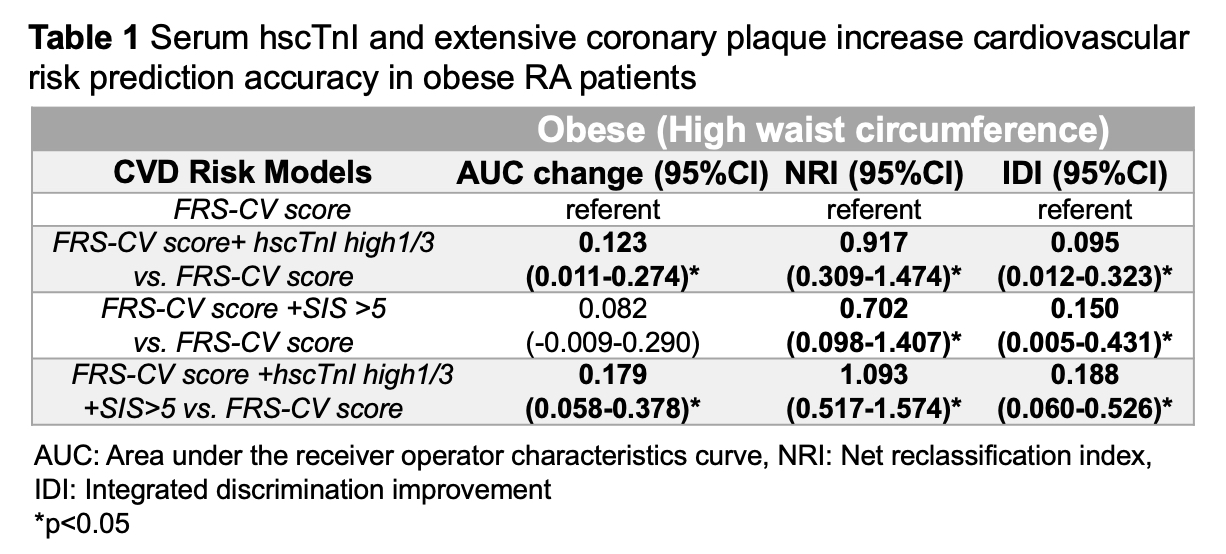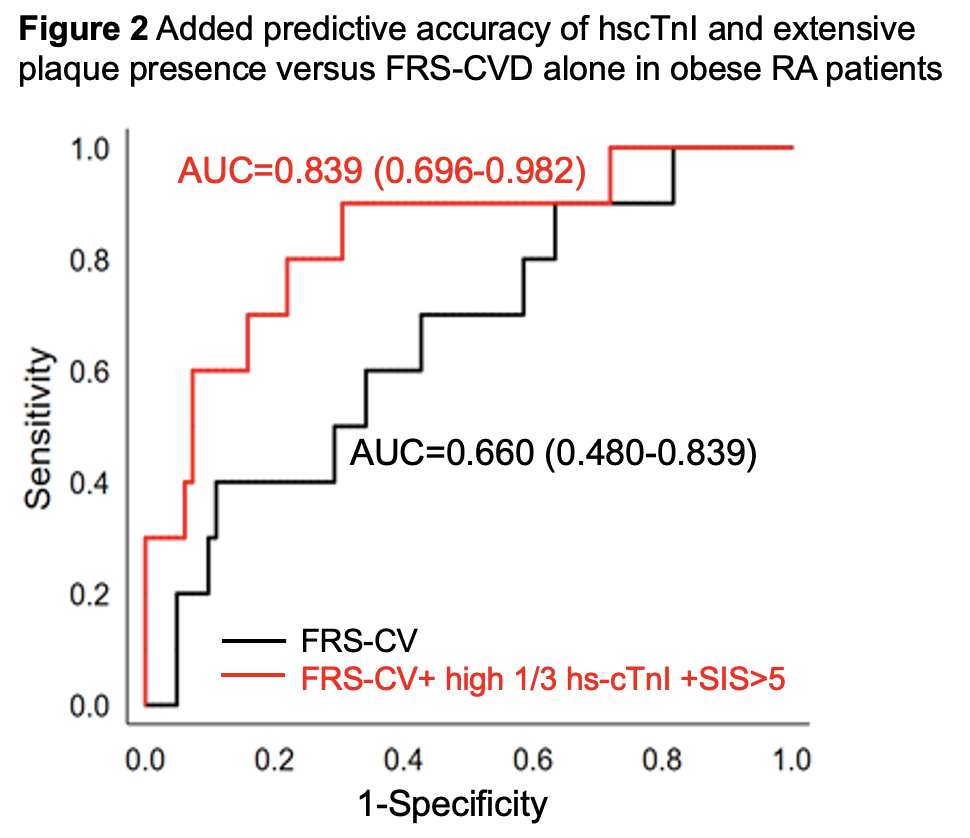Session Information
Session Type: Poster Session A
Session Time: 8:30AM-10:30AM
Background/Purpose: Accurate cardiovascular risk stratification is essential in rheumatoid arthritis (RA) care. Previous studies evaluated the impact of obesity (defined as body mass index) on all cause and cardiovascular disease (CVD) mortality in RA patients. However, the effect of obesity and particularly abdominal (central) obesity on the predictive ability of cardiovascular risk score models in RA is unclear. We explored the obesity-related predictive value of the Framingham Cardiovascular Risk Score (FRS-CVD) in RA patients without known CVD and interrogated the potential utility of cardiovascular imaging and serum biomarkers to improve risk prediction.
Methods: We evaluated 150 RA patients with coronary CT angiography for atherosclerosis assessment and prospective follow-up for cardiovascular events over 6.0±2.4 years. The 10-year FRS-CVD score was computed at baseline. Abdominal obesity was defined as waist circumference >88 cm in females and >102 cm in males. Extensive plaque was defined as having >5 coronary segments with atherosclerosis. Serum highly-sensitive cardiac troponin I (hscTnI) was measured with Erenna immunoassay. Serum leptin, which is closely related to obesity, was measured with radioimmunoassay. Differences in the predictive value of the FRS-CVD in non-obese versus obese and patients and those with high ( >22.1 ng/mL) versus low (< 22.1 ng/mL) leptin were evaluated using area under the curve (AUC) comparisons. The incremental predictive value of extensive plaque and elevated hscTnI ( >2.1, highest tertile) beyond the FRS-CVD was explored using change in AUC, continuous net reclassification index (NRI) and integrated discrimination improvement (IDI).
Results: The predictive accuracy of the FRS-CVD was lower in obese patients (AUC 0.660, [95% CI 0.487-0.832] versus non-obese: AUC 0.95 [95% CI 0.897-1.007], P for difference = 0.002, Figure 1A) and those with higher leptin (AUC 0.618 [95% CI 0.393-0.842]; versus lower leptin: AUC 0.874 [95% CI 0.772-0.976], P for difference = 0.042, Figure 1B). The added predictive ability of hscTnI and extensive plaque was evaluated for obese patients given the observed limitations of the FRS-CVD for this subgroup. Sequential addition of elevated hscTnI and extensive plaque presence to the FRS-CVD base model significantly improved risk prediction estimates based on changes in all AUC, NRI and IDI (Table 1). The final model including hscTnI and extensive plaque accurately predicted 83.9% of CVD events in the obese subgroup (Figure 2).
Conclusion: Cardiovascular risk estimate accuracy was significantly lower in RA patients who were obese. The optimization of cardiac risk stratification with the help of non-invasive assessment of coronary atherosclerosis burden and related cardiac damage biomarkers in the serum may warrant further study.
To cite this abstract in AMA style:
Karpouzas G, ormseth s, Hernandez E, Budoff M. Abdominal Obesity May Confound Accuracy of Cardiovascular Risk Prediction in Rheumatoid Arthritis; Can Coronary Atherosclerosis Imaging and Biomarkers Help? [abstract]. Arthritis Rheumatol. 2021; 73 (suppl 9). https://acrabstracts.org/abstract/abdominal-obesity-may-confound-accuracy-of-cardiovascular-risk-prediction-in-rheumatoid-arthritis-can-coronary-atherosclerosis-imaging-and-biomarkers-help/. Accessed .« Back to ACR Convergence 2021
ACR Meeting Abstracts - https://acrabstracts.org/abstract/abdominal-obesity-may-confound-accuracy-of-cardiovascular-risk-prediction-in-rheumatoid-arthritis-can-coronary-atherosclerosis-imaging-and-biomarkers-help/



